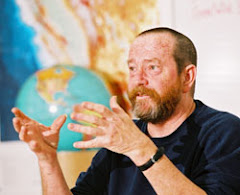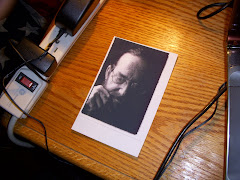Cuento 3: “A History in Flors de Sangre” (886 words)
Ay, Diós mío, señoritas y caballeros, look at that unobstructed view of Honduras across the campo, from mi casita del norte. As you can see, esta vista mágica fronts the long eastern border of “Tierra Mia.” All the casitas, covered now with scarlet bougainvillea, face these sensual yet dangerous mountains, once filled with landmines and Contras and banditos and Mayan warriors, now robbed desnuda of their towering pines and mahogany by log teams in the 50’s. They primed Anastásio Somoza el Segundo’s dictating pockets, over the sixty odd years his family was supported in power by the U.S. Marines.
They put down recurring campesino insurrections—Libertad whistles more loudly to land slaves than to free men, perhaps?--even before the 20’s, when a firebrand named Sandino, from Nueva Segovia, the north country province where I live, rose in arms against the Gringos, the Men in Managua and Somoza, el Primero, then a General, who truced, finally, with this national peon-hero, after many Marines, campesinos and Nationales were killed, all fighting for a version of democracia. Promising land distribution to Sandino’s face, El Jefe then had him shot in the streets, after the Marines had helped to elevate Primero, a peacemaker as it seemed, to Presidente. They also trained his Guardia Nacionál, notorious for torture and bloodletting mayhem, though I hope our boys will never know what vicious sadists and terroristas their students became, with fine-point savvy in mass-intimidating-travesty, after boot camp.
Anastasio, el Segundo, one heinous modelo perfecto for his Guardia, siphoned off gazillions , all here believe , in international aid flooding his Capital City after the 1967 earthquake trembled most of Managua to the ground. Que desastre! The city, when I first saw it in 1993, still looked a bombsite, 25 years after. That was way before I became a don, of course, and before I saw what bombs can do to people, up close, in Teote.
Now the rubble of the former Downtown has been turned under an extensive green parque, nice for the opening evening, after which it filled overnight with thousands of black plastic tents on clothes lines, strung between the newly-planted trees, homes for Managua’s poor and squatting street kids, sniffing glue and selling themselves for a breath of freedom. It’s not a safe place to get off the bus; in fact, I’ve heard, mi amigos, an innocuous tourist lady in a bus, with an over-jeweled hand out the window, lost her rings and fingers to a hungry machete. Managua’s not the best spot for a jewelry convention, nor is Teote, not quite as desperate anymore. I left my gold retirement watch in Colorado on purpose, practical don that I am.
Everything in Nicaragua’s connected, one way or another, to the abuse of the poor, 90% of the population, by the privileged. “Tierra Mia” has witnessed most of it, so every stone tells stories of cruelty and rape and oppressive slavery, for two thousand years, if we figure in the Mayans. They sacrificed slaves, mostly captured war trophies, for every god-appeasing function, including, I suppose, sweet fifteen parties, to flatter marriage gods into sending on rico husbands. Imagine, if you will, losing your heart, possibly right here on “Tierra Mia,” to save a winsome Mayan princess from pimples. Such a rare honor, don’t you think?
Sí, señorita, Mayans marauded the north of Nicaragua, so I’m told by La Doña Estebana, who ought to know, an ancient crone and matriarch of all Teote, a friend of la Brigada de Glenwood Springs. She’s Mom to local star and Sandinista war hero, mayor of Teote through all its Brigada activity, Chindo Sanchez, now mayor of Jalapa.
La Doña says the Mayans, to corral their slaves before the trip to Guatemala, built a stone compound, then a small stone city where the Limon and Poteca rivers come together, just down rio from Quacamaya, mi padre’s finca with the curious non-Hispanic place name. The ancient site—stones vanished into campesino foundations centuries ago--now slithers with poisonous snakes, so everybody stays away, even seed-seekers making beaded curtains. Too much ancient pain, I’d say, and haunted. I’d love to explore it, but avoiding Bushmasters and Corals—as well as pain-- is very high on my Teote have-to agenda: One good bite of the don and I’d be agonizing history, myself, or, worse, paralyzed for life. Luckily, they only live where people don’t.
Somoza Segundo, a pit viper, ran the upper Jalapa Valley, the breadbasket of Nicaragua, as a personal tabaco fiefdom, owning most of it himself, through the shadiest dealing, so say the Teote elders. If he wanted a piece of land, and the owner, usually a campesino struggling to keep his acre, wouldn’t sell, he’d end up dead, shot, skinned while dying, skewered on a sharpened pole for good measure, then dumped in the middle of the disputed piece of land. Slam-bang! It made estate acquisition pretty easy.
His “cattle,” the Sandinistas who eventually overthrew his terror in 1979, worked in his fields for food, like any other domesticated beast. All the elders joke sardonically that every fetid outhouse in Nicaragua now holds a starving, caca-eating parrot named “Segundo” to clean out the hole for free.
Thank God, he’s gone, assassinated after his ouster with silver bullets, the elders say, to keep him in his coffin: “Tierra Mia,” scarlet-stained with bougainvillea, would make a jim-dandy triunfo of a private pool for a dictator and his doxies, complete with imperial, sultry view, here in bloody Nicaragua.
Monday, March 17, 2008
Subscribe to:
Post Comments (Atom)
















































































No comments:
Post a Comment